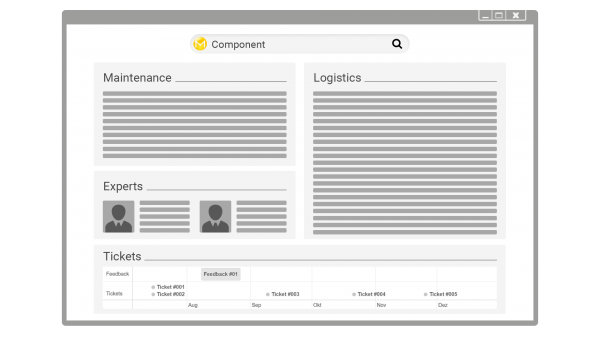Predictive machine maintenance and big data
Every year, defects in machines and systems result in several million hours of downtime worldwide. Business interruptions and production shutdowns caused by defective machinery come with a hefty price tag, on top of the substantial repair costs that are incurred.
Predictive maintenance makes it possible to detect possible defects at an early stage – even before an actual machine failure occurs – which translates into optimized runtimes and machine utilization, along with helping companies to save an enormous amount of time and money.
Instead of being serviced at specified intervals, machines, equipment, or entire systems are continuously monitored using sensors installed directly in the machinery. The sensors measure parameters such as temperature, pressure, and humidity, identify any deviations from the norm, and report potential failures well in advance.
The data overload challenge
In addition to information gathered by the sensors on the various machines and machine parts, data about parameters like outdoor temperature, pressure, humidity, and so on is collected on an ongoing basis. Handling and managing this data is a constant challenge for companies. Yet in combination with the rest of the company’s knowledge, this information is increasingly gaining business-critical relevance. Correctly prepared and analyzed, it yields key insight that can serve as a strategic foundation for decision-making.
In order to analyze this data in the most optimal way, structured preparation is imperative. Insight engines provide quick access to the information at the right time and in the right context.
One technology – All sources – The insight engine
Insight engines integrate information from all corporate sources. They search applications, archives, network drives, document management systems, the intranet, the cloud, and so on, extracting the relevant facts from documents and files and enriching the results with context-specific supplementary information. By linking maintenance logs, technical documentation, expert know-how, and a host of other information, intelligent systems such as insight engines can provide a so-called 360-degree view of each component or piece of equipment. This can be important, for instance, if a component needs to be replaced because of deviations from the norm. With the help of an insight engine, any and all information about manufacturers, suppliers, costs, quality, expert opinions, and contact persons is available at your fingertips with just one simple search query.

The collected results are displayed graphically on a dashboard – in line with the respective access rights – and provide a concise and thorough presentation of all the available information on maintenance, component logistics, contact persons, and more.
Insight engines are thus capable of delivering information on the stress load, reliability, availability, and service life of components and systems to enable a seamless workflow.
Latest Blogs
Inside Insight: How Journeys and Touchpoints Make Enterprise Search Effortless with Mindbreeze Insight Workplace
Picture this: you’re preparing for a high-stakes client meeting.
The Future of Enterprise AI Depends on Smarter RAG Solutions
Today’s enterprise leaders ask how to make AI meaningful, responsible, and scalable. One architectural approach stands out as organizations look beyond isolated proof-of-concepts and begin embedding AI into workflows: Retrieval-Augmented Generation (RAG).


